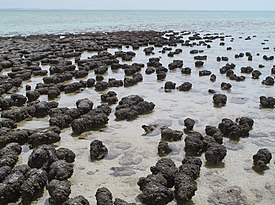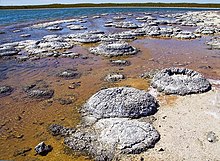Stromatolite: Difference between revisions
m Reverted edits by 77.102.215.52 to last version by NinetyCharacters (HG) |
18.83.6.134 (talk) No edit summary |
||
| Line 1: | Line 1: | ||
[[Image:Stromatolites in Sharkbay.jpg|right|thumb|275px|Modern stromatolites in [[Shark Bay, Western Australia]]]] |
[[Image:Stromatolites in Sharkbay.jpg|right|thumb|275px|Modern stromatolites in [[Shark Bay, Western Australia]]]] |
||
'''Stromatolites''' (from Greek στρώμα, ''strōma'', mattress, bed, stratum, and λιθος, ''lithos'', rock) are layered accretionary [[structure]]s formed in shallow water by the trapping, binding, and cementation of sedimentary grains by [[biofilm]]s of [[microorganism]]s, especially [[cyanobacteria]] (commonly known as blue-green [[algae]]). |
'''Stromatolites''' (from Greek στρώμα, ''strōma'', mattress, bed, stratum, and λιθος, ''lithos'', rock) are layered accretionary [[structure]]s formed in shallow water by the trapping, binding, and cementation of sedimentary grains possibly by [[biofilm]]s of [[microorganism]]s, especially [[cyanobacteria]] (commonly known as blue-green [[algae]]). |
||
==Morphology== |
==Morphology== |
||
Revision as of 15:47, 29 September 2008

Stromatolites (from Greek στρώμα, strōma, mattress, bed, stratum, and λιθος, lithos, rock) are layered accretionary structures formed in shallow water by the trapping, binding, and cementation of sedimentary grains possibly by biofilms of microorganisms, especially cyanobacteria (commonly known as blue-green algae).
Morphology
A variety of stromatolite morphologies exist including conical, stratiform, branching, domal,[1] and columnar types. Stromatolites occur widely in the fossil record of the Precambrian, but are rare today. Very few ancient stromatolites contain fossilized microbes. While features of some stromatolites are suggestive of biological activity, others possess features that are more consistent with "abiotic" (non-organic) precipitation. Finding reliable ways to distinguish between biologically-formed and abiotic (non-biological) "stromatolites" is an active area of research in geology.
Fossil record

Stromatolites were much more abundant on the planet in Precambrian times. While older, Archean fossil remains are presumed to be colonies of single-celled blue-green bacteria, younger (that is, Proterozoic) fossils may be primordial forms of the eukaryote chlorophytes (that is, green algae). One genus of stromatolite very common in the geologic record is Collenia. The earliest stromatolite of confirmed microbial origin dates to 2,724 million years ago.[2]
Stromatolites are a major constituent of the fossil record for about the first 3.5 billion years of life on earth,[3] with their abundance[verification needed] peaking about 1,250 million years ago. They subsequently declined in abundance and diversity, which by the start of the Cambrian had fallen to 20% of their peak. The most widely-supported explanation is that stromatolite builders fell victims to grazing creatures: implying that sufficiently complex organisms were common over 1 billion years ago.[4][5][6]
The connection between grazer and stromatolite abundance is well documented in the younger Ordovician evolutionary radiation; stromatolite abundance also increased after the end-Ordovician and end-Permian extinctions decimated marine animals, falling back to earlier levels as marine animals recovered.[7]

While prokaryotic cyanobacteria themselves reproduce asexually through cell division, they were instrumental in priming the environment for the evolutionary development of more complex eukaryotic organisms. Cyanobacteria are thought to be largely responsible for increasing the amount of oxygen in the primeval earth's atmosphere through their continuing photosynthesis.
Cyanobacteria use water, carbon dioxide, and sunlight to create their food. The byproducts of this process are oxygen and calcium carbonate (lime).[verification needed] A layer of mucus often forms over mats of cyanobacterial cells. In modern microbial mats, debris from the surrounding habitat can become trapped within the mucus, which can be cemented together by the calcium carbonate to grow thin laminations of limestone. These laminations can accrete over time, resulting in the banded pattern common to stromatolites. The domal morphology of biological stromatolites is the result of the vertical growth necessary for the continued infiltration of sunlight to the organisms for photosynthesis.
Modern occurrence
Modern stromatolites are mostly found in hypersaline lakes and marine lagoons where extreme conditions due to high saline levels exclude animal grazing. One such location is Hamelin Pool Marine Nature Reserve, Shark Bay in Western Australia where excellent specimens are observed today, and another is Lagoa Salgada, state of Rio de Janeiro, Brazil, where modern stromatolites can be observed as bioherm (domal type) and beds. Inland stromatolites can also be found in saline waters in Cuatro Ciénegas, a unique ecosystem in the Mexican desert. Modern stromatolites are only known to prosper in an open marine environment in the Exuma Cays in the Bahamas (for excellent underwater photos, see # 197-209: http://strata.geol.sc.edu/Bahamas/BahamasGalleryIndex_3.html).
Layered spherical growth structures named oncolites are similar to stromatolites, and are also known from the fossil record.
See also
- Hamelin Pool Marine Nature Reserve (in western Australia)
- Cuatro Ciénegas (in northern Mexico)
- Oncolite / Oncoid (a spherical -- rather than columnal -- cyanobacterium)
Notes
Cited
- ^ An unusually complete domed stromatolite with a well-preserved upper surface, over 5 feet in diameter, from the Boxley Blue Ridge Quarry near Roanoke, Virginia, was donated to the Virginia Museum of Natural History ("Two-ton, 500 Million-year-old Fossil Of Stromatolite Discovered In Virginia, U.S."), accessed 4 July 2008.
- ^ Lepot, Kevin (2008). "Microbially influenced formation of 2,724-million-year-old stromatolites". Nature Geoscience. 1: 118–21. doi:10.1038/ngeo107. ISSN 1752-0894.
{{cite journal}}:|access-date=requires|url=(help); Unknown parameter|coauthors=ignored (|author=suggested) (help) - ^ Earlier start to life on Earth - Science - Specials - smh.com.au
- ^ McNamara, K.J. (20 December 1996). "Dating the Origin of Animals". Science. 274 (5295): 1993–1997. doi:10.1126/science.274.5295.1993f. Retrieved 2008-06-28.
{{cite journal}}: CS1 maint: date and year (link) - ^
Awramik, S.M. (19 November 1971). "Precambrian columnar stromatolite diversity: Reflection of metazoan appearance" (abstract). Science. 174 (4011): 825–827. doi:10.1126/science.174.4011.825. PMID 17759393. Retrieved 2007-12-01.
{{cite journal}}: CS1 maint: date and year (link) - ^ Bengtson, S. (2002), "Origins and early evolution of predation", The fossil record of predation. The Paleontological Society Papers 8 (Free full text), The Paleontological Society, pp. 289–317, retrieved 2008-06-28
{{citation}}: Unknown parameter|editors=ignored (|editor=suggested) (help) - ^ Sheehan, P.M., and Harris, M.T. (2004). "Microbialite resurgence after the Late Ordovician extinction". Nature. 430: 75–78. doi:10.1038/nature02654. Retrieved 2007-12-01.
{{cite journal}}: CS1 maint: multiple names: authors list (link)
Uncited
- Grotzinger, John P. (1999). "Stromatolites in Precambrian Carbonates: Evolutionary Mileposts or Environmental Dipsticks?". Annual Review of Earth and Planetary Sciences. 27: 313–58. doi:10.1146/annurev.earth.27.1.313. ISSN 1545-4495. Retrieved 2008-05-15.
{{cite journal}}: Unknown parameter|coauthors=ignored (|author=suggested) (help) - Allwood, Abigail C. (2006). "Stromatolite reef from the Early Archaean era of Australia". Nature. 441: 714–8. doi:10.1038/nature04764. ISSN 0028-0836.
{{cite journal}}:|access-date=requires|url=(help); Unknown parameter|coauthors=ignored (|author=suggested) (help)
